Apple's 2010 MacBook Air (11 & 13 inch) Thoroughly Reviewed
by Anand Lal Shimpi on October 26, 2010 10:08 PM EST- Posted in
- Mac
- Apple
- MacBook Air
- Laptops
The 11-inch MacBook Air: Faster than the old 13-inch MacBook Air
On paper, the new 13-inch MacBook Air shouldn’t be any faster than the old 2008 MacBook Air - at least in CPU bound tasks. The 2010 model gets a faster GPU but the CPU is literally the same 1.86GHz Core 2 Duo. Memory sizes and speeds haven’t changed either. While the SSD is faster, if you’re running a CPU bound benchmark there shouldn’t be any performance difference. If you assumed the same thing I did, you’d be very wrong.
Take a look at Cinebench 11 comparing the 2008 13-inch MacBook Air to the two 2010 models:
| Cinebench 11 - Multithreaded CPU Benchmark | |||||
| 11-inch MacBook Air (2010) - 1.4GHz Core 2 Duo | 13-inch MacBook Air (2010) - 1.86GHz Core 2 Duo | 13-inch MacBook Air (2008) - 1.86GHz Core 2 Duo | |||
| Cinebench 11 Score (Higher is Better) | 0.81 | 1.1 | 0.70 | ||
Not only is the 2008 13-inch MBA slower than the new 13-inch model, it’s actually slower than the 11-inch model running at 1.4GHz. Something is amiss. Perhaps it’s just this benchmark?
I turned to our Handbrake H.264 encode test to verify my sanity:
| Handbrake 0.94 - H.264 High Profile Transcode | |||||
| 11-inch MacBook Air (2010) - 1.4GHz Core 2 Duo | 13-inch MacBook Air (2010) - 1.86GHz Core 2 Duo | 13-inch MacBook Air (2008) - 1.86GHz Core 2 Duo | |||
| Average Frames per Second (Higher is Better) | 1.14 fps | 1.55 fps | 0.96 fps | ||
Once again, a similar situation. The old MBA is actually slower than the new 11-inch, despite the advantage in CPU speed.
It looks like what we’ve stumbled upon is a combination of Apple aggressively throttling the clock speed of the older MacBook Air CPUs to meet thermal requirements, and the CPUs used in the new MacBook Airs being far better behaved from a voltage/power consumption standpoint.
The 45nm process these Core 2s are built on is as mature as it’s going to get. I’m guessing yield on these parts is as high as can be and as a result, power consumption is probably consistently lower than the original 1.86GHz parts Apple shipped back in 2008. The peak thermal specs themselves haven’t changed, but the actual power characteristics have.
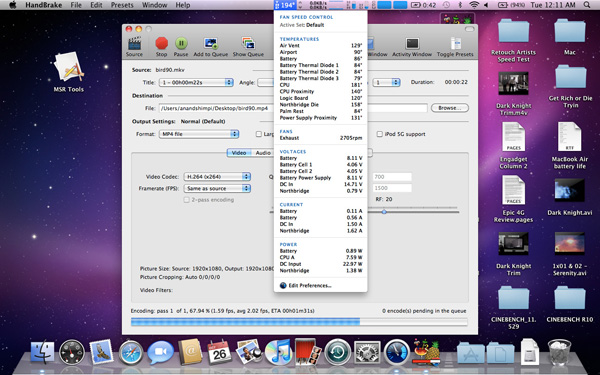
The 2008 MacBook Air under Load
Maximum temperature, at least reported by the MBA’s sensors, isn’t any lower on the new 13-inch than the 2008 I compared it to. Both CPUs hit roughly 84C (183F) under full load. But look at what happens to the chips after a minute at that load:
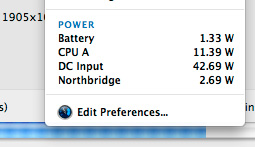 2010 13-inch MacBook Air |
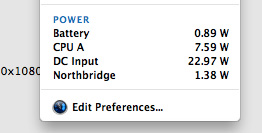 2008 13-inch MacBook Air |
iStat Menus reports the 1.86GHz Core 2 Duo in the 2008 system consuming only 7.59W, while the same CPU in the 2010 machine is drawing 11.45W. The 2008 machine is throttling back to reduce overall temperature while the 2010 system keeps going.
As a result, even the 11-inch MacBook Air will probably end up being as fast, if not faster than the 2nd generation 2008 13-inch MacBook Air. And our performance results confirm that:
| 11-inch MacBook Air (2010) vs. 13-inch MacBook Air (2008) | ||||||||
| Application Launch Test | Adobe Photoshop CS4 | Aperture RAW Import | Cinebench R10 - 1CPU | Cinebench R10 - XCPU | Quicktime H.264 Transcode | |||
| Apple 11-inch MacBook Air (2010) - 1.4GHz Core 2 Duo | 27.8 seconds | 72.4 seconds | 1.29 PPS | 1612 | 2967 | 33.1 fps | ||
| Apple 13-inch MacBook Air (2008) - 1.86GHz Core 2 Duo | 26.4 seconds | 71.3 seconds | 1.20 PPS | 2046 | 2882 | 30.1 fps | ||
You'll notice the less CPU intensive tasks are quicker on the old 13-inch system as the CPU isn't able to get hot enough to trigger Apple's throttling. The single threaded Cinebench test is the best example of this. The 26% performance advantage jibes with the 33% increase in CPU clock speed (it's actually a little low, most likely because the old CPU still isn't running at full speed even in this test). But now look at the heavier tests - the multithreaded Cinebench test and the Quicktime encode. Both of these stress both cores and drive TDP up, which forces Apple to pull clock speed back down. We wondered how Apple was able to cram such a high speed CPU into such a thin chassis as early as it did, now we know.
In practice I found the 2008 13-inch MBA launched applications quicker (short bursts of full clock speed), but after prolonged use or completing CPU intensive tasks it was tough to tell apart from the new 11-inch. What's even more troublesome is that Apple's aggressive clock throttling went relatively undetected until now. This is something I'm going to have to devise tests for and pay more attention to in future reviews. Sneaky, Steve, sneaky.
External Temperatures and Noise
The old MacBook Air chassis had a few dozen slits cut out of the aluminum for ventilation. The new MacBook Air chassis hides the ventilation slits between the base of the unit and the hinge. You can’t see them, but they’re there.
The slits are smaller than they were on the old chassis, which means moving air through them at the same rate sounds louder than before.
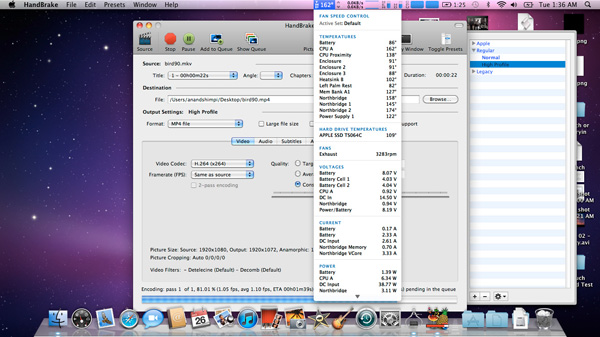
The 11-inch MacBook Air under Load
The CPU in the 11-inch model, even when under heavy loads, likes to stay at or below 72C (162F). At that temperature, the internal fan doesn’t spin above 4000 RPM (usually down below 3400). The 13-inch MacBook Air however is far more likely to generate noise. Running our simple Handbrake test the CPU will peak at over 82C (~180F) and the system’s internal fan will ramp up to over 6K RPM to compensate. Not only does the chassis get hot, but the fan gets audible. It’s still too small of a fan to really be considered loud in the grand scheme of things, but it’s loud enough to be annoying.
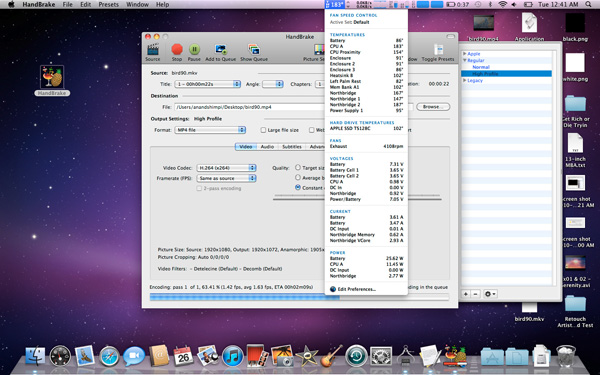
The 13-inch Macbook Air under Load
The surface temperature of the new 13-inch MacBook Air easily gets as high as the 2008 model. I measured a peak of 38.9C (102F) on both the 2008 and 2010 13-inch models. The 11-inch never broke 38C (100F).
Even casual use can ramp up temperatures pretty quickly. Just having a few websites open in the background that use Flash or other CPU intensive elements can slowly cause the MBA’s internal temperatures to rise. And now you’re beginning to see why Apple doesn’t install Flash on these things by default.
The danger zone is the upper left corner of the system, near the hinge. There’s only a single fan that cools both the CPU and GPU in the Air’s very tight enclosure. This is where that fan sits.










185 Comments
View All Comments
quiksilvr - Wednesday, October 27, 2010 - link
The answer:Combined, they will be much less than $800.
THe BRD is an option to add-on, so generally speaking, the normal trend is ~50% higher than the cost for the manufacturer to purchase and install it.
And they can use ANY LV, ULV chip. Start at the lowest and give options for US to choose how high we can go.
The design obviously will be altered somewhat for the ExpressCard slot, but the more I think about it, the more unnecessary it is in this day and age. USB 3.0 will give the speeds. (Also, USB 3.0 controllers aren't ZOMG expensive, they are relatively cheap)
And its not 11, 13, and 15, its 11.6", 13.3" and 15.4" (and 17"). Seriously, 12", 14" and 16" is the best. You hit all three markets: the ultraportable, the general usage, and desktop replacement.
And finally: stop being a douche and lets have a debate rather a name calling contest. Seriously, you wasted a run-on sentence on TARDIS and TARD?
solipsism - Wednesday, October 27, 2010 - link
Again, you've failed to even do the most rudimentary of research or cognitive thinking but somehow came to an $800 retail price point.Intel list their price per 1000 units of LV and ULV chips, and other vendors do sell 9.5mm BRDs (though not the more expensive slot-loading drives, as far as I can tell), and those two items alone are about $800. That's only two components and doesn't include any other costs or a profit margin.
Then you've ignored Apple's choice to focus on slim deaigns. You may not like it (I certainly don't as an 11" MBA with double the battery would be more ideal for my needs) but you need to accept it. Saying "they don't have to make their machines so thin" is a strawman argument so don't even go there.
Seriously, trying looking at actual HW on the market that Apple would potentially use, then price it. Grabbing a price for adiaplay base solely on resolution is pointless. Grabbing a price of a BRD that doesn't fit the space is pointless. Conclusion, your response will likely be pointless.
quiksilvr - Wednesday, October 27, 2010 - link
*takes deep breath*...A Blu ray drive OPTION (NOT STANDARD). The customer will pay for it if they so choose and there are slot load blu ray drives out there from Panasonic, Sony and even Dell.
They don't have to be 9.5 mm they can be 12.7 because the Macbooks (not the Airs, which will not have an optical drive) are ~25 mm thick.
And the slot load Blu Ray DRIVES run for ~$100:
http://www.google.com/products/catalog?hl=en&q...
The slot load Blu Ray BURNERS run for around $250:
http://www.dectrader.com/466803-001-New-HP-4X-Blu-...
So to maintain profits, they would charge $150 for the drive and $350-$400 for the burner.
As for LV and ULV, the most expensive chip I found (ULV cost more than LV) is the Core i7-680UM which runs $317 (if you buy 1000, which I'm sure Apple can afford):
http://ark.intel.com/Product.aspx?id=49664
I think it will be safe to assume (unless you object otherwise) that the ultra low voltage Core i3s and i5s will be noticeably cheaper.
I don't spout out statistics because the information is quite literally a Google search away. I LITERALLY wrote "slot load blu-ray drive" and got those retailers.
quiksilvr - Wednesday, October 27, 2010 - link
Sorry, wrong link. The Blu ray BURNERS cost around ~$350 (damn, no wonder retailers don't sell these in laptops)http://www.amazon.com/DIGISTOR-Blu-ray-Burner-Slot...
So to make it marginally profitable, it would be ~$450-$500 to ADD onto the BASELINE Mac product.
solipsism - Thursday, October 28, 2010 - link
OMG! This guy actually posts a link to a desktop-grade BRD that costs over $350 and suggests it for a Mac notebook that can only take a 9.5mm ultra-slim drive!SERIOUSLY, WTF IS WRONG WITH YOU?!
You have ignored my list of sensible questions to you regarding viability and psychics, and have nonsensically claimed that Apple doesn’t use quality components when even AnandTech, one of the most neutral tech sites around clearly show that the LCD, trackpad and many other aspects are better than the competition.
Look, you don’t have to like a company or their products, but to allow a modicum of common sense into your posts when you claim to be the only sensible one posting is insane. Really, it’s fraking crazy!
quiksilvr - Thursday, October 28, 2010 - link
Siiiiigh.If you clicked the third image, you can clearly see that the HOUSING is what is 43mm and not the drive itself. You can actually see below the connector all that empty space under it.
And things like the trackpad and LCD (especially on 11 and 13" screens) are not much more expensive (do you really want to go through every single minute component just so I can prove to you that it doesn't even come close to the costs I suggested?)
I showed the pricing of the ULV and LV chips are (or at least what the absolute maximum will be for the one that the customer will pay extra for), it has already been established that the RAM, the memory, the screen and the GPU are available on other products for less, and I showed you the Blu ray Drive (the oh so fancy slot one that people want) that ISN'T EVEN STANDARD ON THE BASELINE I RECOMMENDED.
I don't like the company because the company's pricing doesn't make sense. Yes the unibody aluminum is great. I like solid construction. The weight and thinness isn't really a big deal for me, but that doesn't negate the fact that it costs extra and takes effort.
Should Mac products cost more? Of course. But the extent of their pricing lacks common sense and the only reason they are selling so damn well is because consumers have been brainwashed by their marketing tactics and "trend" setting. It makes me sick to my stomach that such a company has made $51 billion dollars over these products.
darwinosx - Tuesday, November 2, 2010 - link
You are not factoring in their far superior service, which cost money, their higher hardware quality control standards, which costs money, the fact that they write their own OS instead of just slapping whatever mediocrity Microsoft is slinging these days, their own hardware design, higher quality hardware manufacturing, or the fact that you are clueless.ImSpartacus - Wednesday, October 27, 2010 - link
I don't think Apple can make those kinds of prices. There are a lot of things that go into a macbook that just aren't found in other laptops.-Giant trackpad
-Decent LCD
-Large battery
-Exceptional build quality
When you cram superior laptop components into a smaller package, it will undoubtedly be more expensive.
darwinosx - Tuesday, November 2, 2010 - link
You have no idea what you are talking about. Back to Mommy's basement.tim851 - Wednesday, October 27, 2010 - link
>>I know this will never happen because it makes too much senseGotta love it when somebody comes along and makes a "more sensible" pricing suggestion to the far and wide most profitable PC hardware manufacturer in the world and the gist of it is: price it more like those competitors that outsell you but earn less money doing it.
You're a genius! You should make the same suggestion to Ferrari: Guys, you can move a whole lot more cars if you just make them cheaper!
For ten years people have been saying that Apple needs to get cheaper. All the while they became ever more successfull. They might technically not be the no.1 computer maker, but they have a higher net income than the rest of the top 10 (probably even top 20) COMBINED. So the last thing they need to do is make their stuff cheaper.